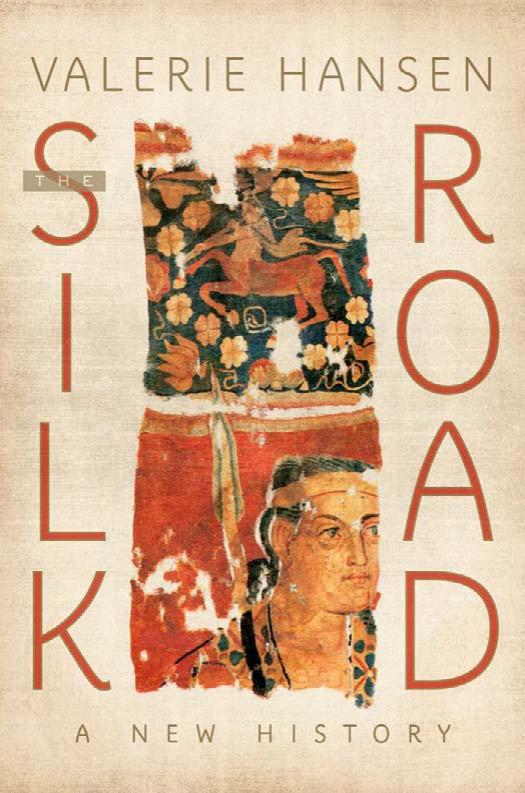The Silk Road: A New History by Valerie Hansen

Author:Valerie Hansen
Language: eng
Format: mobi, epub, pdf
ISBN: 9780195159318
Publisher: Oxford University Press, USA
Published: 2012-08-14T07:00:00+00:00
CHAPTER 6
The Time Capsule of Silk Road History
The Dunhuang Caves
If you are going to visit only one Silk Road site, make it Dunhuang. The physical setting is spectacular. Deep-green poplar and willow trees line the lush oasis. Framed by rocky cliffs, some five hundred caves contain strikingly beautiful Buddhist wall paintings blending motifs from India, Iran, China, and Central Asia. The more than forty thousand scrolls found in the library cave, shown on the next page, form the largest deposit of documents and artifacts discovered anywhere along the Silk Road.1 The texts of different religions placed in the library cave—Buddhism, Manichaeism, Zoroastrianism, Judaism, and the Christian Church of the East—show just how cosmopolitan this community was. Throughout the first millennium, Dunhuang was an important garrison town, Buddhist pilgrimage center, and trade depot. After the year 1000, though, the city gradually declined into a backwater. In 1907, when Aurel Stein made it the destination of his Second Central Asian Expedition, only a handful of Europeans had visited. His discoveries there secured him both a knighthood in Britain and lasting infamy in China.
On his Second Expedition, Stein drew on his earlier experiences of leading a team through the Taklamakan Desert, excavating documents and artifacts, and publishing them responsibly and promptly. In the six years since the First Expedition to Khotan and Niya, Britain’s rivalry with other nations had intensified; the Russians, Germans, Japanese, and French all had teams exploring and removing antiquities from Xinjiang.2 Stein applied for funds so that he could be away for two full years. His goal was to retrace his route from Kashmir to Khotan and then travel through the desert all the way to Dunhuang, on the western edge of Gansu Province, which lay 800 miles (1,325 km) away as the crow flies, 950 miles (1,523 km) by road.
Stein first learned about the Dunhuang caves in 1902, when the Hungarian geologist Lajos Lóczy gave a paper at a congress of Orientalists in Hamburg, Germany. Lóczy had been one of the first Europeans to visit the site in 1879; at the time only two monks lived year-round at the near-deserted site. Although an expert in soil and rocks, Lóczy identified the importance of the Buddhist murals in the caves, which Chinese scholars tended to ignore in favor of scroll paintings.3 The earliest wall paintings at Dunhuang dated to the fifth century CE, much earlier than any surviving painting on silk.
Download
The Silk Road: A New History by Valerie Hansen.epub
The Silk Road: A New History by Valerie Hansen.pdf
This site does not store any files on its server. We only index and link to content provided by other sites. Please contact the content providers to delete copyright contents if any and email us, we'll remove relevant links or contents immediately.
The Leavers by Lisa Ko(6496)
Born to Run: by Christopher McDougall(6288)
iGen by Jean M. Twenge(4708)
Sapiens by Yuval Noah Harari(4560)
The Kite Runner by Khaled Hosseini(4489)
Spare by Prince Harry The Duke of Sussex(4228)
Bullshit Jobs by David Graeber(3194)
Livewired by David Eagleman(3140)
Goodbye Paradise(2986)
Never by Ken Follett(2919)
A Dictionary of Sociology by Unknown(2523)
Harry Potter 4 - Harry Potter and The Goblet of Fire by J.K.Rowling(2423)
The Club by A.L. Brooks(2383)
People of the Earth: An Introduction to World Prehistory by Dr. Brian Fagan & Nadia Durrani(2354)
Machine Learning at Scale with H2O by Gregory Keys | David Whiting(2326)
The Social Psychology of Inequality by Unknown(2321)
Harry Potter and the Order of the Phoenix (5) by J.K. Rowling(2244)
Harry Potter and the Deathly Hallows (7) by J.K. Rowling(2240)
0041152001443424520 .pdf by Unknown(2231)
